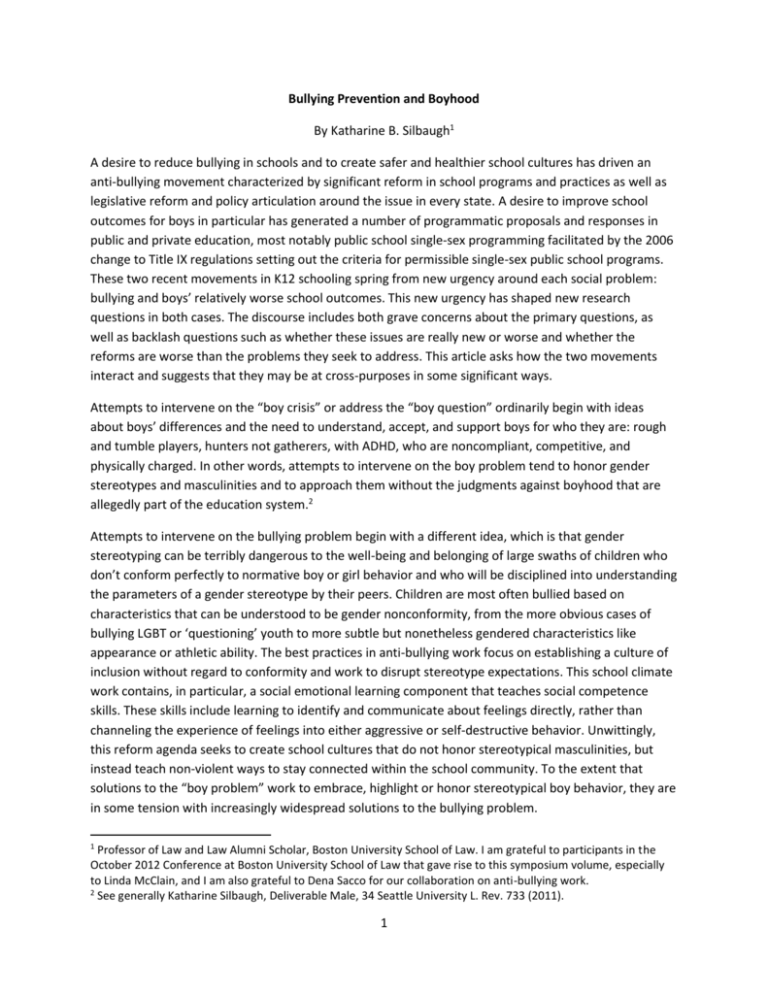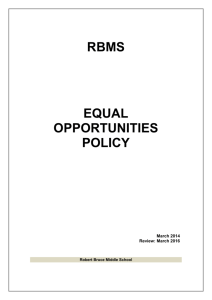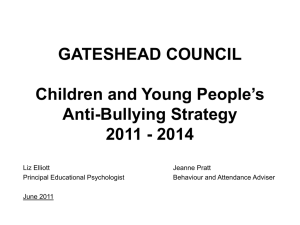Bullying Prevention and Boyhood By Katharine B. Silbaugh1 A
advertisement

Bullying Prevention and Boyhood By Katharine B. Silbaugh1 A desire to reduce bullying in schools and to create safer and healthier school cultures has driven an anti-bullying movement characterized by significant reform in school programs and practices as well as legislative reform and policy articulation around the issue in every state. A desire to improve school outcomes for boys in particular has generated a number of programmatic proposals and responses in public and private education, most notably public school single-sex programming facilitated by the 2006 change to Title IX regulations setting out the criteria for permissible single-sex public school programs. These two recent movements in K12 schooling spring from new urgency around each social problem: bullying and boys’ relatively worse school outcomes. This new urgency has shaped new research questions in both cases. The discourse includes both grave concerns about the primary questions, as well as backlash questions such as whether these issues are really new or worse and whether the reforms are worse than the problems they seek to address. This article asks how the two movements interact and suggests that they may be at cross-purposes in some significant ways. Attempts to intervene on the “boy crisis” or address the “boy question” ordinarily begin with ideas about boys’ differences and the need to understand, accept, and support boys for who they are: rough and tumble players, hunters not gatherers, with ADHD, who are noncompliant, competitive, and physically charged. In other words, attempts to intervene on the boy problem tend to honor gender stereotypes and masculinities and to approach them without the judgments against boyhood that are allegedly part of the education system.2 Attempts to intervene on the bullying problem begin with a different idea, which is that gender stereotyping can be terribly dangerous to the well-being and belonging of large swaths of children who don’t conform perfectly to normative boy or girl behavior and who will be disciplined into understanding the parameters of a gender stereotype by their peers. Children are most often bullied based on characteristics that can be understood to be gender nonconformity, from the more obvious cases of bullying LGBT or ‘questioning’ youth to more subtle but nonetheless gendered characteristics like appearance or athletic ability. The best practices in anti-bullying work focus on establishing a culture of inclusion without regard to conformity and work to disrupt stereotype expectations. This school climate work contains, in particular, a social emotional learning component that teaches social competence skills. These skills include learning to identify and communicate about feelings directly, rather than channeling the experience of feelings into either aggressive or self-destructive behavior. Unwittingly, this reform agenda seeks to create school cultures that do not honor stereotypical masculinities, but instead teach non-violent ways to stay connected within the school community. To the extent that solutions to the “boy problem” work to embrace, highlight or honor stereotypical boy behavior, they are in some tension with increasingly widespread solutions to the bullying problem. 1 Professor of Law and Law Alumni Scholar, Boston University School of Law. I am grateful to participants in the October 2012 Conference at Boston University School of Law that gave rise to this symposium volume, especially to Linda McClain, and I am also grateful to Dena Sacco for our collaboration on anti-bullying work. 2 See generally Katharine Silbaugh, Deliverable Male, 34 Seattle University L. Rev. 733 (2011). 1 I. The Boy Problem Others have described the boys in education problem and provided excellent critical perspective on the discourse.3 In schools, boys are underperforming girls on a number of measures that Michael Kimmel has summarized as “numbers, achievement, and behavior”.4 The number of boys is problematic across several axes, because boys drop out or are expelled from school at higher rates than girls, so fewer boys graduate from high school, enroll in college, finish college, and enroll in graduate school. This is especially true for boys of color. The achievement underperformance is evidenced in their lower performance on a variety of language arts measures, their lower GPAs, and their lower test scores in some subjects. The behavior part of boys’ underperformance has a number of components, including: higher rates of diagnosis of behavioral disorders, emotional disturbance, and Attention Deficit/Hyperactivity Disorder; higher rates of suicide than girls; and higher levels of engagement in other risky behaviors like drunk driving. It also includes higher violence rates: boys fight more, they commit more crimes, and they are more likely to be victims of violent crime. Differences among boys track the same demographics as the drop-out and expulsion rates; boys of color are more likely to be victims of violent crime.5 The discussion of the boy crisis in schools regularly deploys the masculinities that Michael Kimmel explicates in his work: boys are distinctive because they engage in rough and tumble behavior, have ADHD, they are noncompliant, they are physically charged, they are competitive, and they prefer action and plot to feelings and relationships.6 The conventional policy concern expressed within the boy crisis dialogue is that schools don’t handle these masculine attributes well. Schools, it is said, are designed for girls, because schools require boys to sit for long periods and to cooperate with those who they view as competitors, to discuss the point of view within a novel and to comply with classroom rules. Some policymakers would like to separate boys from girls to address these concerns, while others would feed these concerns into a co-educational classroom but bring awareness of these purported variations in needs to those environments. The ethos of the boy crisis discourse is that these typical boy behaviors should not be pathologized, but should be honored and valued nonjudgmentally. Boys should not be made to give up their boyish nature to succeed in school. The concern, and critiques of the concern, are well-articulated from Caryl Rivers to Michael Kimmel, so I will shortcut the discussion of boyhood portrayed in this “boy question” discourse in order to talk about the anti-bullying movement that has swept through schools. This law and policy reform may have initiated an unwitting shift in gender culture. The chronology of that shift might be described as 3 E.g. Michael Kimmel, Guyland (2008); Caryl Rivers and Rosalind Barnett, The Truth About Girls and Boys: Challenging Toxic Stereotypes About Our Children (2011); http://quod.lib.umich.edu/cgi/t/text/textidx?cc=mfsfront;c=mfs;c=mfsfront;idno=ark5583.0014.001;rgn=main;view=text;xc=1;g=mfsg ; Leonard Sax, Boys Adrift: The five factors driving the growing epidemic of unmotivated boys and underachieving young men (2009). 4 http://quod.lib.umich.edu/cgi/t/text/textidx?cc=mfsfront;c=mfs;c=mfsfront;idno=ark5583.0014.001;rgn=main;view=text;xc=1;g=mfsg 5 http://nces.ed.gov/fastfacts/display.asp?id=49; 6 http://www.aclu.org/files/assets/doe_ocr_report2_0.pdf; Katharine Silbaugh, Deliverable Male, 34 Seattle University L. Rev. 733 (2011). 2 followed: an apparent bullying crisis leads to legislation, which incentivizes schools to reduce bullying, which leads to the adoption of curriculum that has been shown to reduce bullying, which includes the teaching of skills that disrupt masculine norms as a byproduct. II. The Bullying Problem A. The Harms of Bullying While the roots of the anti-bullying movement can be found prior to the Columbine High School shootings in 1999, that incident, in which two high school students widely reported to be the victims of bullying, rampaged their school with assault weapons. They killed one teacher and twelve students and injuring twenty-one others, before committing suicide themselves.7 Concern about both violence and suicide may sustain much of the interest in bullying reduction in the public discourse, but policymakers also have been spurred by developments in the research on the long-term consequences of bullying, including school attendance and school performance difficulties, depression, criminal activity, and substance abuse.8 The anti-bullying movement didn’t arise out of thin air; it has its footing in a series of other movements. The anti-bullying movement pulls together a number of micro-issues and concerns with old roots and gathers those, with their different players, under one loose umbrella. Lady Gaga’s Born this Way Foundation, for example, explicitly resists the anti-bullying label in favor of a youth empowerment mission called “The Kinder and Braver World” project, and engages actors from a variety of fields to address bullying.9 The related fields that comprise the anti-bullying movement include: youth suicide prevention; youth drop-out prevention, with an eye both on school avoidance by bullying targets and excessive school discipline and zero tolerance policies against bullying aggressors; school violence prevention; gun violence prevention; hazing prevention (including an earlier round of anti-hazing legislation); youth mental health support; social-emotional curriculum and education; and identitybased equality concerns, including gay rights, disability rights, and sexual harassment and Title IX concerns. 7 Brooks Brown and Rob Merritt, No Easy Answers: the Truth Behind Death at Columbine (2002). There is some dispute over the role bullying played in the lives of the two killers, and the role bullying played in their decisions and their suicides, but no real dispute that Columbine was the catalyst for increased discussion of bullying. 8 See generally,Victoria Stuart-Cassel, Ariana Bell, and J. Fred Springer, Analysis of State Bullying Laws and Policies, ix (U.S. Department of Education 2011) http://www2.ed.gov/rschstat/eval/bullying/state-bullying-laws/statebullying-laws.pdf; Juvonen, Jaana, Yueyan Wang, and Guadalupe Espinoza. 2010 Bullying Experiences and Compromised Academic Performance Across Middle School Grades. The Journal of Early Adolescence. 31(1):152– 173; Ivarsson, Tord, Anders G. Broberg, Tomas Arvidsson, and Christopher Gillberg. 2005. “Bullying in Adolescence: Psychiatric Problems in Victims and Bullies as Measured by the Youth Self Report (YRS) and the Depression SelfRating Scale (DSRS).” Nordic Journal of Psychiatry. 59(5):365–373; Craig, Wendy M. 1998. “The Relationship Among Bullying, Victimization, Depression, Anxiety, and Aggression in Elementary School Children.” Personal and Individual Differences. 24(1):123–130; Gastic, Billie. 2008. “School Truancy and the Disciplinary Problems of Bullying Victims.” Educational Review. 60(4):391–404. 9 http://cyber.law.harvard.edu/node/7523. 3 B. The Legal Response In little more than a decade, a new legal infrastructure has arisen in response to school bullying. In 1999, the first anti-bullying law was passed, partly in the reflective aftermath of the Columbine shootings. Today, 49 states have passed anti-bullying laws, and some states have come around for a second round of more nuanced and robust state law.10 Virtually every student in the United States has been directly touched by anti-bullying legislation in the past decade; it’s hard to overstate the potential force of this movement within the US education system. The prior movements, such as the youth suicide prevention movement or the identity-based equality movement, each deserve credit for highly-developed literature and intervention initiatives, and some interventions arising out of those fields do touch on legal issues. But the recent legislative reforms explicitly characterized as anti-bullying legislation have been remarkably comprehensive and widespread. The reforms are so recent that there is no rigorous assessment of their impact on student behavior, but I would argue that their impact may be greater over the long term than some law-makers may appreciate. A number of different features of these laws channel schools toward the same goal: reducing incidents of bullying. Schools are incentivized over and over by different parts of the law to figure out the path to reducing bullying, wherever that path leads. It’s possible that the path to reducing bullying will involve a substantial cultural change, as discussed below in section III. The anti-bullying laws, which vary by state, have some typical characteristics. The earliest statutes were sometimes hortatory: they encouraged school districts to adopt anti-bullying policies or to study bullying, without actually requiring action from schools or districts. Later statutes, however, become more robust, both in specificity and in mandates. While anti-bullying statutes vary by state, they usually contain much of the following.11 1. A focus on schools as the target of the legislation, meaning the regulated entity. Media coverage of these laws sometimes appears to assume that the children are the regulated entity, but few statutes place requirements or consequences on children in any meaningful way. 2. A requirement that schools have anti-bullying policies. Frequently, the legislation will include requirements for what is in the policies. These statutory requirements may include a definition of bullying, which may require inclusion of identity-based groups such as LGBT students, students of color, or students with disabilities. The requirement that policies include mention of bullying on the basis of these characteristics has caused controversy in numerous state legislatures, supporting the notion that state legislatures do not obviously seek to initiate the significant departure from cultural norms that I argue will result from these laws. 3. A requirement that staff report bullying to school leadership, which tracks research indicating that adult intervention often has been inadequate. 10 Dena T. Sacco, Katharine Silbaugh, Felipe Corredor, June Casey and Davis Doherty, An Overview of State AntiBullying Legislation and Related Laws, http://cyber.law.harvard.edu/sites/cyber.law.harvard.edu/files/State_Anti_bullying_Legislation_Overview_0.pdf. 11 Sacco, Silbaugh, et al (id). 4 4. A requirement that bullying incidents reported to school leadership be investigated. Sometimes the legislation requires school policies to state and publish consequences for particular behaviors in advance, and to follow through on those published expectations. In other words, these statutes require clearly stated expectations and process once bullying has been reported. These portions of the laws are sometimes critiqued as too closely resembling a “law enforcement” model, although the statutes don’t typically prescribe any consequence and leave schools free to craft educational responses to incidents rather than law enforcement responses. Whichever direction a school chooses for its published anti-bullying expectations and consequences, the requirement that schools respond to all incidents according to their own processes raises the salience of bullying for school leadership and incentivizes schools to reduce incidents of bullying. 5. Most laws require reporting and record-keeping, which sheds sunlight on school performance at reducing bullying and thereby applies pressure to reduce bullying within each building. 6. While a number of the provisions mentioned thus far apply indirect pressure on schools to prevent bullying, later laws also require more explicit and direct bullying prevention efforts. These usually include educating staff, students and parents about the school’s anti-bullying policies and educating students and staff about bullying dynamics as reflected in the research on bullying prevention. Often the laws also require schools to adopt a bullying prevention curriculum, in some cases requiring that those curricula be “evidence-based”. While schools are already given a natural incentive to adopt bullying prevention curriculum by other attributes of these laws such as reporting requirements and intervention requirements, the requirements that a school devote curricular energy to reducing the incidents of bullying moves a step further. Nothing in this curriculum requirement indicates that the agenda of these laws is to encourage schools to change their gender culture, but as I argue in section III, it may do so nonetheless. For a range of reasons, including highly publicized bullying-related suicides and school violence, advances in research about the short and long-term consequences of bullying, and new electronic communication methods that leave an evidentiary trail of the tenor of some youth interactions, awareness of bullying in youth culture has risen in recent years driving cultural, educational, and legal attention to the issue. The legal interventions incentivize schools to reduce bullying, and the tools available to achieve that goal may disrupt well-established gender norms as a byproduct of reducing the number of bullying incidents. III. The Unwitting Disruption of Gender Norms The bullying prevention provisions of state laws that include curricula and social competence skills training interact richly with the boy question previewed in Section I. An anti-bullying curriculum teaches children behaviors to avoid, including physical and social aggression. But the most popular and effective programs also focus on creating a positive school climate because a negative school climate and bullying rates are correlated. Social science research about bullying positions it as, in significant part, a symptom of a problematic school climate, not simply as evidence of problematic individual children. The programs that work to reduce the number of incidents take the following frame: it is the climate of the school, not 5 individual bad apples. Because evidence-based curricula—meaning curricula that have been shown to significantly reduce the incidence of bullying—focus on improving school climate, new anti-bullying legislation incentivizes schools to actively manage their peer ecology.12 A. School Climate School climate is a term used to describe the social and emotional atmosphere pervading the school community.13 It’s “inputs” are quality of relationships among kids and between kids and adults, and the real social norms for behavior, including behaviors around inclusiveness and the feeling of belonging. A positive school climate is correlated with low levels of bullying, and movement from a weaker school climate to a more positive one reduces bullying. In a positive school environment, bullying is not seen as a rule violation, but as a violation of relationships.14 An important element in achieving a positive school climate is a social emotional learning program that will improve the social competence of children. The Collaborative for Social, Emotional, and Academic Learning (CASEL) surveyed the research to come up with the core set of skills to be taught in any SEL program.15 These skills are standard in the kind of SEL program that anti-bullying legislation incentivizes. The main skills taught in a social curriculum are self-awareness (identifying your feelings), selfmanagement (expressing those emotions constructively and not expressing them destructively), social awareness (empathizing), and relationship skills (establishing healthy relationships based on cooperation and resolving interpersonal conflicts constructively).16 These individual skills are taught to children to improve the entire peer ecology.17 The results of improvements in social climate are shown to be quite dramatic for children’s emotional experience according to student surveys, for schools’ academic performance, and in reducing incidents of bullying.18 It is uncontroversial to characterize these gains as positive. But it is also worth appreciating that in requiring curricula that teach adjustments to our basic process of socialization in order to achieve these goals, we may be mapping out a fairly significant cultural shift in norms of interaction for children that could carry into the adult world. The teaching of skills aimed at constructing an emotionally safe environment within schools may give rise to shifts in social norms and practices for the children in those schools as they mature into adults. The implications of those shifts for some of the larger cultural tensions familiar within American culture, including but certainly not limited to gender performance, are not explicit in the discussions of these reforms. They find only episodic and poorly articulated expression 12 http://schoolclimate.org/climate/documents/policy/sc-brief-v5.pdf http://www.schoolclimate.org/prevention/documents/bully-prevention-research-what-works.pdf 14 http://www.prevnet.ca/LinkClick.aspx?fileticket=YeZors2sJD8%3d&tabid=392; see also http://www.mass.gov/ago/docs/community/bullying/submitted-testimony/limber-2011-journal-of-schoolviolence-development-evaluation-and-future-directions-of-the-olweus-bullying-prevention-program.pdf. 15 http://www.lpfch.org/sel/PackardES-REV.pdf (page 4). 16 http://casel.org/wp-content/uploads/SEL-and-Bullying-Prevention-2009.pdf; http://www.lpfch.org/sel/PackardES-REV.pdf 17 http://casel.org/wp-content/uploads/Elbertson_Brackett__Weissberg_SEL_Overview.pdf 18 http://www.lpfch.org/sel/PackardES-REV.pdf; http://casel.org/wpcontent/uploads/Elbertson_Brackett__Weissberg_SEL_Overview.pdf; 13 6 in the legislative debates, as when state efforts to express support for bullied LGBT youth are set against protecting the moral or religious feelings of teachers or more conservative students who want to stake out legitimacy for disapproval of LGBT individuals. The recent legislative battle in Michigan over the form that anti-bullying legislation would take focused on this particular tension. These legislative debates do explicitly surface cultural conflict. However, those legislative debates are not characterized by inquiry over the future modes of expression (e.g. meta-cognition in recognizing one’s own emotions and those of others), but only over the topics of expression (the moral embrace or disapproval of LGBT youth).19 We might expect the possibility of a larger cultural shift to be a rich area for further investigation. In bringing to the surface the relationship between anti-bullying efforts and the “boy crisis” reforms, I only begin to identify a part of the new terrain created by these legal interventions. In sum, schools are newly energized by a number of forces, including legal forces, to want to reduce bullying. They want to know what works to get the reportable incidence number down. They are driven to embrace efforts whose efficacy is based in research. What works, according to research, are efforts to create a healthy whole school climate of belonging and inclusiveness. That climate can be achieved by teaching children social competence skills. Those particular skills disrupt the impulse to channel emotions through aggressive behavior including physical contact, instead encouraging empathy and higher level communication skills. Those social climate changes challenge some gendered expectations for boys, as discussed below in section III B. At various stages of development, social-emotional education is the work going on in schools or the charge to schools under many anti-bullying statutes. This work is a direct result of these laws, because they either require social competence work in a social curriculum, or they incentivize it because it is the one thing shown to work to reduce bullying. B. gender nonconformity and the informal emotional education of boys 1. gender nonconformity and bullying LGBT and questioning youth are overwhelmingly more likely to be targets of bullying than are other children.20 Because relatively older youth self-identify as LBGT, it’s a difficult topic to study during the prime bullying years, which peak between 13 and 15. But researchers have developed scales of greater and lesser gender conformity in younger children, and produced the unsurprising finding that gender nonconforming boys are more likely to be the target of bullying.21 In addition, when children are surveyed about the basis for bullying, they report in high numbers bases for bullying like appearance and athletic ability that can be proxies for gender conformity.22 19 For a general discussion of the Michigan controversy, see http://www.mlive.com/politics/index.ssf/2011/11/state_senate_abandons_anti-bul.html 20 http://www.glsenboston.org/GLSENFromTeasingToTorment.pdf 21 Elizabeth J. Meyer, Gender, Bullying, and Harassment: Strategies to End Sexism and Homophobia in Schools 8 (2009); Jean M. Baker, How Homophobia Hurts Children 39 (2002); Michael Kimmel, Manhood in America: A Cultural History (2005). 22 Jean M. Baker, HOW HOMOPHOBIA HURTS CHILDREN (2002); Ann C. McGinley, Masculinities at Work, 83 OR. L. REV. 359 (2004); David S. Cohen, No Boy Left Behind? Single-Sex Education and the Essentialist Myth of Masculinity, 84 IND. L. J. 135 (2009). 7 Girls and boys often experience bullying aggression differently. Girls’ aggression can take many forms, but is more likely to be verbal and to include social exclusion.23 Boys are far more likely to experience physical aggression from other boys.24 Some research suggests that the boy who is most likely to be a continuous target of physical aggression by boys is the one who does not respond in kind to rough and tumble physical contact and who does not voluntarily choose to engage in horseplay.25 2. rough and tumble play and boys’ emotional education Rough and tumble play is widespread among boys, especially relative to girls. Some research on rough and tumble play suggests that developmentally, boys use it to learn to manage boundaries and to communicate those boundaries to each other, even though it may not teach these skills any more effectively than other play.26 Rough and tumble play is sometimes framed in the psychology literature as boys learning to communicate.27 In other words boys engage in “physical communication”, and they learn communication skills from that physical contact. On that framing, the boy who doesn’t engage in rough and tumble play doesn’t communicate with boys in their own boy language. That boy is also the boy most likely to be the target of bullying. Here is a particularly rich explanation of this process, describing studies of juvenile rats: We think it important to note that because play fighting is an inherently social behavior, when juvenile rats do not do it, they become socially incompetent as adults (Pellis and Pellis 2007). Such rats overreact to benign social contact, such as social sniffing. This makes them hyperdefensive, and they are more likely to escalate encounters to aggression (Einon and Potegal 1991; Potegal and Einon 1989). Furthermore, when they are introduced into rat colonies, these rats fail to exhibit the appropriate submissive behavior when confronting dominant males, and they persistently attract aggressive attacks. They also fail to adopt strategies to circumvent attracting the ire of dominant rats (Hol et al. 1999; van den Berg et al. 1999; von Frijtag et al. 2002). Also, rats without juvenile play experiences remain overly stressed after encountering such situations (von Frijtag et al. 2002). Finally, these rats appear to have difficulty coordinating their movements with those of their social partners (Moore 1985; Pellis et al. 1999).28 Without putting any stake into the relationship between rat play and juvenile boys, we can observe that this research exemplifies the humanized observations of cause and effect around rough and tumble play and emotional education. It might go without saying, but this paper notes that the sex of the rat matters. The human research on rough and tumble play may be more subtle, but it offers similar gender 23 http://www2.ed.gov/rschstat/eval/bullying/state-bullying-laws/state-bullying-laws.pdf (page 2). http://www2.ed.gov/rschstat/eval/bullying/state-bullying-laws/state-bullying-laws.pdf (page 2). 25 http://scholars.law.unlv.edu/cgi/viewcontent.cgi?article=1018&context=facpub; Tiram Gamliel et al., A Qualitative Investigation of Bullying, 24 SCH.PSYCHOL. IN'L 405 (2003). 26 http://www.journalofplay.org/sites/www.journalofplay.org/files/pdf-articles/3-4-article-lafreniere-evolutionaryfunctions-social-play.pdf ; A. D. Pellegrini Boys' rough-and-tumble play, social competence and group composition British Journal of Developmental Psychology 11 (might not be any better at teaching social competence than the alternatives) 27 http://www.epjournal.net/wp-content/uploads/ep043303462.pdf 28 http://www.journalofplay.org/sites/www.journalofplay.org/files/pdf-articles/2-3-article-function-playdevelopment-social-brain.pdf (page 7) 24 8 narratives that connect essential communication skills and social development to boys’ physical contact.29 If physical contact has been central to our cultural practice of educating boys emotionally, whether grounded in animal studies and neuropsychology or instead in unscientific cultural norms, than an explicit school-based social emotional curriculum that seeks to channel the identification of feelings into more meta-cognitive communication practices marks a shift worthy of attention. 3. Bullying in single-sex schools versus co-ed schools Many concerned about boys in school look to single sex environments to improve boys’ school experience. The revised Title IX regulations appeared to generate a vast increase in the amount of single sex programming in public schools.30 Built into this movement are politics of recognition. Proponents have generated a narrative of victimization based on stereotypical male traits. Single-sex schooling, by contrast, is offered to celebrate boys’ differences from girls. The embrace of these purported differences runs contrary to some threads in the most prominent anti-bullying curricula, raising the question of how single sex classrooms or schools compare to co-ed classrooms and schools on bullying measures. The research on bullying in single-sex schools is scant. The U.S. Department of Education, in its 2005 Report evaluating research that compares single-sex to coeducational schooling on many metrics concluded that “bullying in school did not appear in a single study of sufficient quality to be reviewed.”31 In May 2009, an unpublished dissertation by Dominique Johnson at Temple concluded that 32 evaluation of bullying in single sex schools produces different results when gender is factored into the study. She evaluates the impact of gender by parsing out the difference between gender conforming students and gender nonconforming students, and she also considers the amount of gender conformity in the particular school. She finds that gender nonconforming boys and girls are more likely to be bullied than gender conforming boys and girls. She seems to find that single sex schools are safer for nonconforming girls, but the safety of the school seems to turn on how much gender conformity is in the entire institution. She doesn’t think there is data to support a strong finding about boys, but what she does find is that the story is reversed: gender-nonconforming boys are at greater risk in single sex school 29 http://www.epjournal.net/wp-content/uploads/ep043303462.pdf, e.g. page 11: “In summary, the findings relating to single gender play supported previous human and non-human animal observational findings in this area, indicating a greater prevalence of R&T among all-boy play groups in terms of amount, pace and intensity, and a gender difference in R&T based fantasy narratives that reflect the findings of Kyratzis (2000, 2001) and Marsh (2000). Such findings are compatible with the theory of an evolved, gendered bio-psychological “template.” Gendered bio-psychology can therefore be theorized to be both utilized and further developed in commensurate physical play and associated narrative during early childhood: “males and females have evolved different strategies for maximizing their inclusive fitness… and these strategies develop in interaction with a child’s social and physical environment” (Bjorklund and Pellegrini, 2000, pp. 1690-1694).” 30 See Rosemary Salomone, this volume, e.g. 31 U.S. Department of Education, Office of Planning, Evaluation and Policy Development, Policy and Program Studies Service, Single-Sex Versus Secondary Schooling: A Systematic Review, Washington, D.C., 2005 at 87 (available at http://www.ed.gov/about/offices/list/opepd/reports.html) 32 Dominique Johnson dissertation. 9 environments. Students are more likely to be victimized when they do not conform to their school’s gender norms. The inconclusiveness in this literature increases concern arising from the rough and tumble play literature that nonconforming boys are punishable, either by their peers through bullying, or by single sex institutions that seek to cultivate conforming characteristics. To the extent that these institutions promote the physical communication identified by some as particularly male, they promote forms of expression that run contrary to those supported by CASEL which have been demonstrated to reduce bullying incidents and to create a positive school climate. What do we ask boys to do when we set them apart based on a premise that they embody a set of stereotypical and distinct traits associated with school failure? The robust literature on stereotype threat suggests that students adopt characteristics expected of their group.33 Findings across many identity-based groups about school performance would suggest that separating boys based on their special academic deficits would have a similar impact. But more important to the question of bullying and socialization, the operation of the stereotype threat process has been shown with respect to men’s lack of social sensitivity: men perform down on this measure when expected to.34 Single-sex education may run directly contrary to the social emotional learning trends incentivized by the anti-bullying legal reforms. C. The New Hidden Gender Curriculum Having looked at the boy crisis, anti-bullying statutes, social-emotional learning programs, the tie between gender non-conformity and bullying, and boys’ “physical communication,” we can return to questions of law and policy. While it is too soon to understand the scope of the impact of the antibullying law, the potential operation of legal incentives on significant cultural changes in gendered communication styles ought to be appreciated now. The policies and curricula either required or incentivized by anti-bullying statutes generally lead to school and district audits of bullying, meaning surveys of kids about their experiences on a periodic basis.35 In addition to all the other reasons to evolve on school climate issues, these audits put pressure on school leadership to improve their results because they can be published to the community. Some schools without the capacity to address them properly might be expected to engage in compliance charades that accomplish little, whether by embracing zero tolerance policies or by publishing policies that are ignored.36 But other schools are genuinely incentivized to succeed on this metric, and they are broadening the circle, from a zero tolerance, incident-based approach to bullying, to a social curriculum 33 M. Cadinu, et al. Stereotype threat: The effect of expectancy on performance. European Journal of Social Psychology, 33, 267–285 (2003). 34 A. M. Koenig, and A.H. Eagly, Stereotype threat in men on a test of social sensitivity. Sex Roles, 52, 489-496 (2005). 35 When statutes require evidence-based curricula, they in effect require these surveys, because the few antibullying programs that meet the evidence-based criteria use an annual survey. Audits also occur because schools are often required by statute to report the number of incidents, and their resolution, to state departments of education. See generally Sacco, Silbaugh, et al. 36 See generally John Brehm and Scott Gates, Working, Shirking, and Sabotage: Bureaucratic Response to a Democratic Public (1999). 10 and climate and culture approach, which is the one that’s been shown to work to decrease incidents of bullying. That social curriculum approach is currently being deployed in many schools in response to anti-bullying legislation. We can expect it will be deployed in many more as laws tighten and as results from more tepid interventions continue to disappoint. The social curriculum approach teaches all children to learn to recognize their own emotions, express them directly rather than indirectly, with words rather than physicality, to empathize with others, and to adhere to social norms that require respecting the belonging of others instead of seeking advantage over others. Schools are teaching cooperation and inclusion and redirecting competitive behaviors not based on a broad cultural judgment, but because those schools are motivated to reduce bullying. The consequences of this curricular change may turn out to reach farther than lawmakers intended. That is not to say the further reach is a negative one, by any means, only an unintended one. Lawmakers do not seem to have set out to make a kinder world with greater emotional awareness and pro-social communication styles. They certainly did not discuss feminizing modes of communication, or disrupting masculine modes of communication among school children. They seem to have set out to reduce the number of serious bullying incidents and bullying connected suicides. Yet as we walk through the practical stages of an evidence-based effective approach to bullying, we see the unfolding of a school culture that, unwittingly, disrupts the masculine performance of emotions, rather than celebrating it as much of the boy crisis-oriented policy would have us do. It’s not just a trend within schools or within educational circles. It’s a trend spawned by legal change. Michael Kimmel has written, “that in the current climate, boys need defending against precisely those who claim to defend them; they need rescuing from precisely those who would rescue them.”37 It might be that the anti-bullying statutes will lead school leadership—leadership with no particular interest in gender nonconformity--to do as Michael Kimmel suggests, and rescue boys from those in the boy crisis movement who would rescue them. Conclusion The anti-bullying movement does not use language suggesting that it’s about “disrupting masculinities.” Further, the reformers themselves, and the school administrators who enact the reforms, don’t conceive of the reforms as being about gender, though all are aware that LGBT children are particularly vulnerable and that they have been one political engine and focus in the debate. Instead of being selfconsciously about disrupting masculinities, the reform movements aim at reducing bullying incidents. That goal is generating research on what works and what doesn’t, and the research is informing policy and practice. These evidence-based school climate curricula are not viewed as disrupting gender patterns. But they do aim to re-arrange major characteristics of school and peer culture. They aim to create more inclusive and tolerant environments where students are better at identifying and articulating their own emotions and recognizing those of others, and where children view aggressive behavior as a relationship violation contrary to community social norms. In their successful incarnations, 3737 http://quod.lib.umich.edu/cgi/t/text/textidx?cc=mfsfront;c=mfs;c=mfsfront;idno=ark5583.0014.001;rgn=main;view=text;xc=1;g=mfsg 11 they produce a building full of adults and children who interact with each other in a lower conflict setting by identifying and expressing their feelings directly. This represents a movement toward a normative school culture, for policy reasons, that does not reify non-verbal, competitive, rough and tumble forms of communication, because those are prone to being indirect and not inclusive, and because they don’t include the self-conscious step of identifying feelings. School leaders pursuing this path obviously do not view boys as incapable of acquiring these skills. The behaviors that are celebrated non-judgmentally as ‘boys’ difference’ in the’ boy question’ discussion are discouraged because they are linked to an increased likelihood of bullying. It would be hard to overstate the potential reach of this anti-bullying reform movement, with its social emotional learning components, on school culture. Policymakers supporting a celebration of boy culture, or focusing on boy needs, have some decisions to make about goals and values that may not cohere well across these different targets of reform. 12








